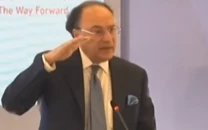Banks lend almost all deposits to govt
Leave nothing for private sector to finance their businesses

Commercial banks have lent a record 98.55% of total deposits to the government at significantly high returns, leaving almost nothing for the underperforming private sector, which is termed the engine of economic growth.
According to the State Bank of Pakistan’s (SBP) monthly update, banks provided total financing of Rs28.92 trillion to the government by the end of May 2024, taking the investment-to-deposit ratio (IDR) to 98.55% as deposits grew to Rs29.35 trillion.
Background information suggests the government resorted to aggressive domestic commercial borrowing due to a shortfall in revenue (tax and non-tax) collection and the obligation to make interest payments on the swelling debt.
Commercial banks have continued to borrow money from the central bank to subsequently finance the government. The cost of bank borrowing from the SBP has come down somewhat after the central bank cut its key policy rate by 150 basis points to 20.5% last week.
Commercial bank financing for the government spiked almost 44% to Rs28.92 trillion in May 2024 compared to Rs20.14 trillion in the same month a year ago, according to the central bank data.
On the other hand, bank financing for the private sector remained stagnant at Rs12.17 trillion in May, demonstrating a meagre increase of less than 1% in the past one year from Rs12.07 trillion in May 2023.
Accordingly, the banks’ advance-to-deposit ratio (ADR) slumped to 41.46% in May 2024 compared to almost 50% in May 2023.
Most of the banks avoid providing risky financing to the private sector, which is needed to support economic activities and job creation in the country. Instead, they mainly make risk-free lending to the government to mint money.
According to financial experts, the cost of bank borrowing has skyrocketed in the last one year, which makes it unfeasible for the private sector to secure credit for ramping up production activities. The has caused the reduction in the ADR.
Deposits soar 20%
Meanwhile, commercial bank deposits grew over 20% to Rs29.35 trillion in May 2024 compared to Rs24.39 trillion in May 2023.
The growth in deposits came mainly from two sources – a significant rise in workers’ remittances and government borrowing from banks.
Remittances hit a record high of $3.24 billion in May 2024, which pushed total inflows to $27.09 billion in the first 11 months of FY24, up 7.7% year-on-year.
Such inflows have supported the growth in deposits as the recipients of remittances usually deposit their savings in banks.
Secondly, government borrowing from banks surged Rs8.78 trillion, or 43.59%, in the past one year to Rs28.92 trillion, which mostly remained in the system and continued to reflect in bank deposits.



















COMMENTS
Comments are moderated and generally will be posted if they are on-topic and not abusive.
For more information, please see our Comments FAQ